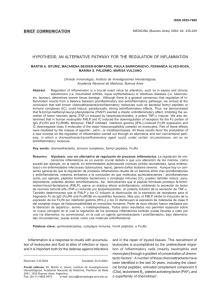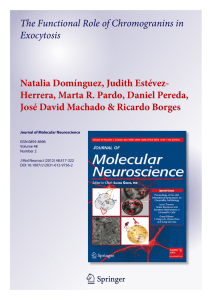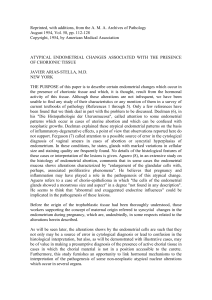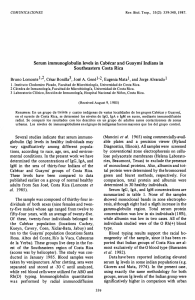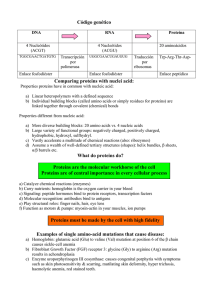Tumor Necrosis Factor-α Upregulates the Expression of
Anuncio
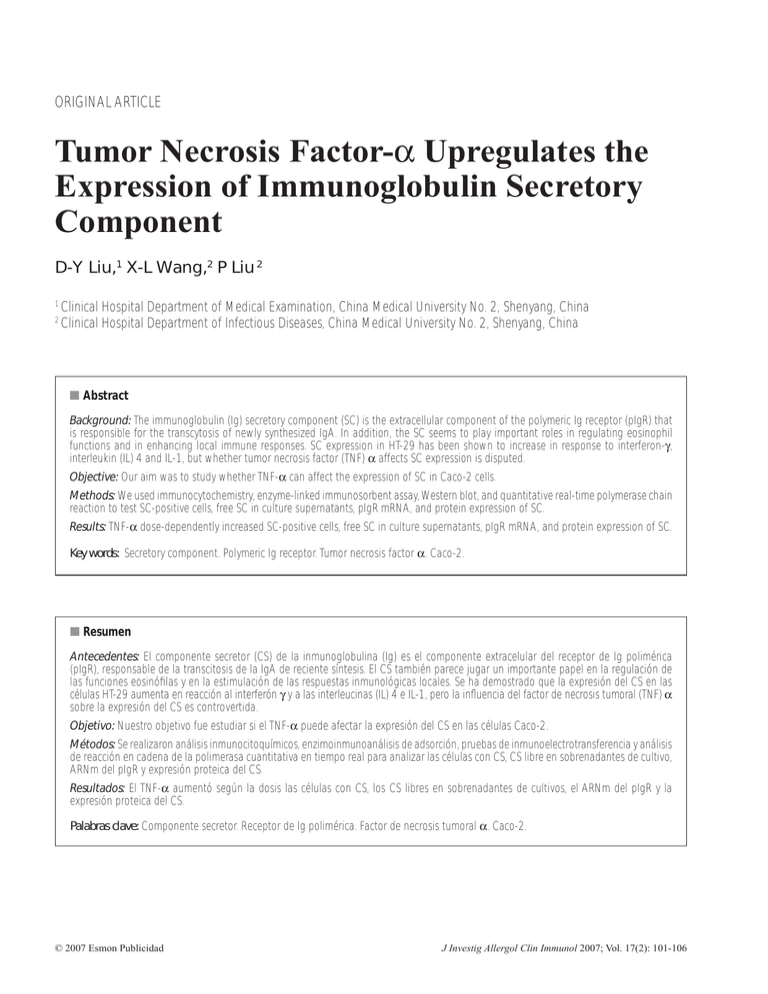
TNF-α and Immunoglobulin Secretory Component Expression ORIGINAL ARTICLE Tumor Necrosis Factor-α Upregulates the Expression of Immunoglobulin Secretory Component D-Y Liu,1 X-L Wang,2 P Liu 2 1 2 Clinical Hospital Department of Medical Examination, China Medical University No. 2, Shenyang, China Clinical Hospital Department of Infectious Diseases, China Medical University No. 2, Shenyang, China ■ Abstract Background: The immunoglobulin (Ig) secretory component (SC) is the extracellular component of the polymeric Ig receptor (pIgR) that is responsible for the transcytosis of newly synthesized IgA. In addition, the SC seems to play important roles in regulating eosinophil functions and in enhancing local immune responses. SC expression in HT-29 has been shown to increase in response to interferon-γ, interleukin (IL) 4 and IL-1, but whether tumor necrosis factor (TNF) α affects SC expression is disputed. Objective: Our aim was to study whether TNF-α can affect the expression of SC in Caco-2 cells. Methods: We used immunocytochemistry, enzyme-linked immunosorbent assay, Western blot, and quantitative real-time polymerase chain reaction to test SC-positive cells, free SC in culture supernatants, pIgR mRNA, and protein expression of SC. Results: TNF-α dose-dependently increased SC-positive cells, free SC in culture supernatants, pIgR mRNA, and protein expression of SC. Key words: Secretory component. Polymeric Ig receptor. Tumor necrosis factor α. Caco-2. ■ Resumen Antecedentes: El componente secretor (CS) de la inmunoglobulina (Ig) es el componente extracelular del receptor de Ig polimérica (pIgR), responsable de la transcitosis de la IgA de reciente síntesis. El CS también parece jugar un importante papel en la regulación de las funciones eosinófilas y en la estimulación de las respuestas inmunológicas locales. Se ha demostrado que la expresión del CS en las células HT-29 aumenta en reacción al interferón γ y a las interleucinas (IL) 4 e IL-1, pero la influencia del factor de necrosis tumoral (TNF) α sobre la expresión del CS es controvertida. Objetivo: Nuestro objetivo fue estudiar si el TNF-α puede afectar la expresión del CS en las células Caco-2. Métodos: Se realizaron análisis inmunocitoquímicos, enzimoinmunoanálisis de adsorción, pruebas de inmunoelectrotransferencia y análisis de reacción en cadena de la polimerasa cuantitativa en tiempo real para analizar las células con CS, CS libre en sobrenadantes de cultivo, ARNm del pIgR y expresión proteica del CS. Resultados: El TNF-α aumentó según la dosis las células con CS, los CS libres en sobrenadantes de cultivos, el ARNm del pIgR y la expresión proteica del CS. Palabras clave: Componente secretor. Receptor de Ig polimérica. Factor de necrosis tumoral α. Caco-2. © 2007 Esmon Publicidad J Investig Allergol Clin Immunol 2007; Vol. 17(2): 101-106 102 DY Liu, et al Introduction Secretory component (SC) is the extracellular component of the polymeric immunoglobulin (Ig) receptor (pIgR) that is responsible for the transcytosis of newly synthesized IgA. It is a transmembrane glycoprotein localized on glandular epithelial cells and represents the 5 exodomains of a larger transmembrane epithelial protein [1-3]. SC that has translocated polymeric immunoglobulin functions is an important protein in the mucosal immune system and it is a key antibody in mucosal immune defenses [4,5]. SC plays a protective role in preventing the proteolytic degradation of polymeric IgA, enhancing the mucosal immunity provided by IgA at these sites; in addition basolateral to apical movement of the pIgR can occur in the absence of ligand, resulting in the release of free SC apically [6]. Free SC has been shown to fix the complement component C3b in vitro, suggesting a role of SC in enhancing local immune responses [6]. In vitro binding of free or complexed SC to a specific SC receptor on eosinophils was discovered to induce eosinophil degranulation, also suggesting that SC may play important roles in regulating eosinophil functions [7]. Free SC can inhibit Escherichia coli adhesion to HeLa cells and is thus a key defense against E coli [8]. In humans, SC can connect with ricin protein and prevent it from adhering to intestinal mucosa [9]. The Caco-2 cell monolayer is a model of intestinal epithelial cells with the same enzymes, transporters, and morphology as intact human intestinal epithelial cells [10]. As in another colon cell line, HT29, it has been shown to be possible to detect SC in Caco-2 cells [11]. In many reports, SC expression in HT29 has increased in response to proinflammatory cytokines such as interferon (IFN) γ, tumor necrosis factor (TNF) α, interleukin (IL) 4 and interleukin ( IL) 1 [12-16]. However, TNF-α failed to affect SC expression in another study [17]. In the present study, our aim was to study whether TNF-α can affect expression of SC in Caco-2 cells. for 30 minutes and then washed again with distilled water 3 times. Caco-2 cells on cover glasses were incubated with 3% hydrogen peroxide (H2O2) and then washed with water 3 times. For SC staining, sections were reacted with 10 % goat serum for 30 minutes and then reacted with mouse anti-human SC at 4 C over night. The sections were washed with phosphatebuffered saline (PBS) and incubated with biotin-goat F(ab’)2 anti-mouse IgG for 30 minutes and with avidin-peroxidase for 30 minutes. The sections were rinsed 3 times with PBS between each incubation, and sections were counterstained with hematoxylin. Sections from the same cells processed without the primary antibody were determined with the procedure detailed above as a control for nonspecific binding of the secondary antibody. Enzyme-Linked Immunosorbent Assay Measurement of SC The amounts of SC secreted into the supernatants were measured by enzyme-linked immunosorbent assay (ELISA). Briefly, 96-well microtiter plates were coated with mouse anti-human SC mAb overnight at 4 C, then washed with PBS, and each well was incubated with 1% bovine serum albumin in PBS to block any nonspecific binding. After washing with PBS containing 0.1% Tween-20, 100 µL supernatant with SC was added into each well. Then each well was incubated with peroxidase-labeled polyclonal anti-human specific IgA antibody for 30 minutes. Then 0.1 M acetate buffer containing 1 mg/mL ortho-phenylenediamine was prepared and 3 µL of that solution in 10 mL of H2O2 was added to each well. The reactions were stopped by adding 25 µL of 2M sulfuric acid. The absorbance of each solution was determined at a wavelength of 450 nm. Western Blot Analysis of SC Protein in Caco-2 Cells Materials and Methods Cell Culture Caco-2 cells were derived from the American Type Culture Collection (Manassas, Virginia, USA). Caco-2 cells were grown on 25-mm plastic Petri dishes at 37 C in air and 5% carbon dioxide in Dulbecco’s Modified Eagle Medium (DMEM, GiBCO, Invitrogen Co, Carlsbad, California, USA.), supplemented with 20 % fetal calf serum (FCS), 2 mM of L-glutamine, 0.1 % pyruvate sodium, 1 % nonessential amino acids, 100 IU/mL of streptomycin, 100 IU/mL of penicillin, and 3.7 g/L of sodium hydrogen carbonate. Caco-2 cells were cultured in this medium for 1 week. When confluent, cells were cultured in FCS-free DMEM containing the required amounts of TNF-α for 24 hours. Immunocytochemistry After being washed with normal saline 3 times, Caco-2 cells were fixed on cover glasses with 4 % paraformaldehyde J Investig Allergol Clin Immunol 2007; Vol. 17(2): 101-106 Extracted proteins of Caco-2 cells were separated by sodium dodecyl sulfate polyacrylamide gel electrophoresis and transferred to polyvinylidene fluoride membranes. The membranes were blocked with Tris-buffer containing 50 ng/L skim milk and probed with polyclonal mouse anti-human SC antibodies or ß-actin followed by peroxidase-conjugated secondary antibody. They were then incubated with an enhanced chemiluminescent substrate and exposed to X-OMAT film. Quantitative Real-Time Polymerase Chain Reaction Total cellular RNA was measured as described earlier [18,19]. Briefly, total cellular RNA was extracted from Caco-2 cells using the RNeasy Mini Kit from Takara Biotechnology Corp, Dalian, China). The quality of extracted RNA was determined by agarose gel electrophoresis. cDNA was synthesized using 100 ng of RNA. The levels of individual RNA transcripts were quantified by quantitative real-time © 2007 Esmon Publicidad TNF-α and Immunoglobulin Secretory Component Expression polymerase chain reaction (PCR). The primers of SC were pIgR–F: 5’-TGTTGCCACCACTGAGAGCAC-3’; pIgR-R: 5’-CTTTGTAGGCCATCTCGGCTTC-3’; GAPDH–F: 5’GCACCGTCAAGGCTGAGAAC-3’; and GAPDH–R: 5’ATGGTGGTGAAGACGCCAGT-3’. Primers and fluorescent probes for SC and standard were purchased from Takara. The PCR conditions comprised a preliminary cycle of 95 C for 10 seconds, followed by 45 cycles of 95 C for 5 seconds and 60 C for 20 seconds, followed by 60 C for 1 minute and 95 C for 5 seconds. We also confirmed that efficiency of amplification of each target gene (GAPDH) was 100% in the exponential phase of the PCR. We determined the levels of mRNA of the test and GADPH according to the standard. The mRNA levels were normalized to GADPH mRNA by dividing SC gene copies of samples by the SC gene copies of GAPDH. The RNA level of untreated Caco-2 cells was assumed to be 1, and other treated Caco-2 cells were compared with it. control. The SC was localized mainly in the cytoplasm and cell membranes of Caco-2 cells. ELISA of SC in Caco-2 Cells Incubated With TNF-α We found that SC could not be detected with ELISA in Caco-2 cells incubated without TNF-α, but SC increased in culture supernatants of Caco-2 cells incubated with TNF-α in a dose-dependent manner (Figure 2.) SC protein of Caco-2 cells detected by Western Blot The molecular weight of SC is 80 kD and indeed there was a remarkable band located at 80 kD (Figure 3A). The levels of SC protein were higher in Caco-2 incubated with TNF-α. The mean ± SD optical density levels of SC protein were 186 ± 1.6, 196 ± 2.1, 203 ± 1.9, 205 ± 2.3, respectively, when the doses of TNF-α were 50 ng/mL, 100 ng/mL, 200 ng/mL, and 400 ng/mL; these values were significantly higher than those observed for untreated Caco-2 cells (178 ± 1.5) (P < .01) (Figure 3B). Statistical Analysis Statistical differences among treatment groups were determined by t test with SPSS version 10.0. Results Immunochemical Analysis of the Effect of TNF-α on SC-Positive Cells Real-time PCR Analysis of SC in Caco-2 Cells Caco-2 cells were cultured for 24 hours with TNF-α, and mRNA levels were determined in steady-state by real-time PCR for SC. The mRNA levels of these target genes were normalized by the mRNA levels of the housekeeping gene GADPH. The mRNA level of Caco-2 cells untreated with TNF-α was assumed to be 1 for comparison with the mRNA levels of treated Caco-2 cells. Expression of SC mRNA was significantly higher in response to various concentrations of TNF-α (Figure 4.) Immunocytochemistry demonstrated that the SC-positive cells accounted for about 0.1 % to 0.5 % of Caco-2 cells cultured in the absence of TNF-α (Figure 1A). Treatment of Caco-2 cells with TNF-α at concentrations of 50 ng/mL, 100 ng/mL, 200 ng/mL, and 400 ng/mL for 24 hours increased the proportions of SC-positive cells to approximately 0.5% to 1%, 1.5% to 2%, 2% to 3%, and 3.0% to 3.5%, respectively (Figures 1B, 1C, 1D, and 1E). Figure 1F is the negative A D © 2007 Esmon Publicidad B E 103 C F Figure 1. TNF-α-induced an increase in the percentage of SC-positive cells in Caco-2 cells cultures (24 hours). B) 50 ng/mL, C) 100 ng/mL, D) 200 ng/mL, E) 400 ng/mL, and F) negative control. J Investig Allergol Clin Immunol 2007; Vol. 17(2): 101-106 104 DY Liu, et al Optical Density 0.6 0.5 0.4 0.3 0.2 0.1 0 0 50 100 200 400 TNF-α Dose (ng/mL) Figure 2. The relation of SC secretion in Caco-2 cells to dose of TNF-α. The samples were cultured in triplicate. A ß-actin 80 kD B Medium Optical Density 220 * * 210 * 200 * 190 180 Figure 3. Effect of TNF-α on the expression of secretory component (SC) in Caco-2 cells. A) Specific bands for SC: 0 ng/mL, 50 ng/mL, 100 ng/mL, 200 ng/mL, and 400 ng/mL. B) Densitometric analysis (n = 5 in the group, * P < .01 vs each preceding dose). 170 160 0 50 100 200 400 Content of SC, Normalized to GADPH mRNA TNF-α Dose (ng/mL) 6 * 5 * 4 3 * 2 * 1 0 0 50 100 TNF-α Dose (ng/mL) J Investig Allergol Clin Immunol 2007; Vol. 17(2): 101-106 200 400 Fi g u r e 4 . D o s e - d e p e n d e n t enhancement of secretory component (SC) mRNA expression in Caco-2 cells with treatment of TNF-α (* P < .01). The mRNA levels were normalized to GADPH mRNA © 2007 Esmon Publicidad TNF-α and Immunoglobulin Secretory Component Expression Discussion TNF-α is a secretory product derived from several types of cells, although activated macrophages are the most important source [20]. It is a proinflammatory cytokine that is now known to be a key regulator of intestinal immunity and to have roles in organogenesis of peripheral lymphoid structures, activation of innate antiviral and antibacterial responses, and transmission of signals to initiate adaptive immune response [21]. The intestinal barrier prevents bacteria and toxins from escaping from the gut lumen through the intestinal wall. The intestinal barrier functions by mechanisms that are mechanical, immunological and chemical and microorganisms play a part. The immunological barrier of the intestine is made up of M cells, epithelium lymphocytes, lymphocytes within the lamina propria and secretory IgA; this last component consists of IgA, SC, and J chain. SC bound to IgA mediates transepithelial transportation of IgA into the gut lumen. It has been estimated that pIgR (SC)-mediated transport of IgA by intestinal epithelium cells results in the daily delivery of 3g of secretory IgA into the intestine in a average adult [18]. Secretory IgA in the intestine acts as the first line of antigen-specific immune defense against pathogens, and regulates inflammatory responses to pathogens as well as commensal bacteria [18]. Because a molecule of pIgR (SC) is consumed by every molecule of IgA transported, regulation of pIgR expression is essential for maintenance of intestinal homeostasis [18]. In this study, our data showed that TNF-α rapidly enhanced the synthesis and active secretion of SC in a dosedependent manner in cultures. Likewise, immunochemistry confirmed that TNF-α stimulated the amplification of the number of SC-positive cells in a dose-dependent manner. Western blot determination of SC protein of Caco-2 cells also showed that the increase in the amount of SC protein of Caco-2 cells was dose-dependent. Furthermore, the upregulation of SC mRNA expression by TNF-α in Caco-2 cells was dose-dependent. TNF-α has been reported to cause a dramatic increase in expression of pIgR mRNA levels [19]. High expression of SC would be important to limit the inflammatory response to bacterial and viral products, via epithelial transportation of IgA anti-lipopolysaccharide Abs [22] and through the anti-inflammatory function of the SC [23]. It is an important discovery that SC gene products classically associated with acute inflammatory response may play a role in limiting inflammation and promoting tissue repair [19]. Our observations confirm that SC expression is upregulated by TNF-α, which plays an important role in limiting acute inflammation. Acknowledgment This work was supported by National Science Foundation of China grant 30670947 and the Education Committee of Liao Ning (grant 05L466). © 2007 Esmon Publicidad 105 References 1. Mostov KE, Kraehenbul JP, Blobel G.. Receptor-mediated transcellular transport of immunoglobulin: synthesis of secretory component as multiple and larger transmembrane forms. Proc Natl Acad Sci. 1980;77:7257-61. 2. Mostov KE, Blobel G.. A transmembrane precursor of secretory component. The receptor for transcellular transport of polymeric immunoglobulins. J Biol Chem. 1982; 257:11816-21. 3. Mostov KE, Friedlander M, Blobel G.. The receptor for transepithelial transport of IgA and IgM contains multiple immunoglobulin-like domains. Nature. 1984;308:37-43. 4. Brandtzaeg P, Prydz H. Direct evidence for an integrated function of J chain and secretory component in epithelial transport of immunoglobulins. Nature. 1984;311:71-3. 5. Brandtzaeg P. Role of J chain and secretory component in receptormediated glandular and hepatic transport of immunoglobulins in man. Scand J Immunol. 1985;22:111-46. 6. Marshall LJ, Perks B, Ferkol T, Shute JK. IL-8 released constitutively by primary bronchial epithelial cells in culture forms and inactive complex with secretory component. J Immunol. 2001;167:281623. 7. Motegi Y, Kita H, Kato M, Morikawa A. Role of secretory IgA, secretory component, and eosinophils in mucosal inflammation. Int Arch Allergy Immunol. 2000;122 Suppl 1:25-7. 8. De Araujo AN, Giugliano LG.. Lactoferrin and free secretory component of human milk inhibit the adhesion of enteropathogenic Escherichia coli to Hela cells. BMC Microbiol. 2001;1:25. 9. Mantis NJ, Farrant SA, Mehta S. Oligosaccharide side chains on human secretory IgA serve as receptors for ricin. J Immunol. 2004;172:6838-45. 10. Yokomizo A, Moriwaki M. Transepithelial permeability of myricitrin and its degradation by simulated digestion in human intestinal Caco-2 cell monolayer. Biosci Biotechnol Biochem. 2005;69(9):1774-6. 11. Takenouchi-ohkubo N, Asano M, Chihaya H, Chung-hsuing WU, Ishikasa K, Moro I. Retinoic acid enhances the gene expression of human polymeric immunoglobulin receptor (pIgR) by TNF-α. Clin Exp Immunol. 2004;135:448-54. 12. Sollid LM, Kvale D, Brandtzaeg P, Markusseg G, Thorsby E. Interferon-γ enhances expression of secretory component, the epithelial receptor for polymeric immunoglobulins. J Immunol. 1987;138:4304-6. 13. Kvale D, Lovhaug D, Sollid LM, Branditzaeg P. Tumor necrosis factor-? up-regulates expression of secretory component, the epithelial receptor for polymeric Ig. J Immunol. 1988;140:30869. 14. Phillips JO, Everson MP, Moldoveanu Z, Lue C, Mestecky J. Synergistic effect of IL-4 and IFN-γ on the expression of polymeric Ig receptor (secretory component) and IgA binding by human epithelial cells. J Immunol. 1990;145:1740-4. 15. Denning GM. IL-4 and IFN-γ synergistically increase total polymeric IgA receptor levels in human intestinal epithelial cells. J Immunol. 1996;156:4807-14. 16. Hayashi M, Takanouchi N, Asano M, Kato M, Tsurumachi T, Saito T, Moro I. The polymeric immunoglobulin receptor (secretory component) in a human intestinal epithelial cell line is upregulated by interleukin-1. Immunology, 1997;92:220-5. J Investig Allergol Clin Immunol 2007; Vol. 17(2): 101-106 106 DY Liu, et al 17. Hamada Y, Kobayashi K, Brown WR. Tumor necrosis factor-alpha decreases expression of the intestinal IgG Fc binding site by HT29-N2 cells. Immunology. 1991; 74:298-303. 18. Schneeman TA, Bruno MEC Schjerven H, Johansen FE, Chady L, Kaetzel CS. Regulation of the polymeric Ig receptor by signaling through TLRs3 and 4: linking innate and adaptive immune response. J Immunol. 2005;175:376-84. 19. Bruno MEC, Kaetzel CS. Long-term exposure of the HT-29 human intestinal epithelial cell line to TNF-α causes sustained up-regulation of the polymeric Ig receptor and proinflammatory genes through transcriptional and post-transcriptional mechanisms. J Immunol. 2005;174:7278-84. 20. Nathan CF. Secretory products of macrophages. J Clin Invest. 1987; 79:319-26. 21. Pfeffer K. Biological functions of tumor necrosis factor cytokines and their receptors. Cytokine Growth Factor Rev. 2003;14:18591. 22. Fernandez MI, Pedron T, Tournebize R, Olivo-Marin JC, Sansonetti PJ, Phalipon A. Anti-inflammatory role for intracellular dimeric J Investig Allergol Clin Immunol 2007; Vol. 17(2): 101-106 immunoglobulin A by neutralization of lipopolysaccharide in epithelial cells. Immunity. 2003;18: 739-49. 23. Phalipon A, Corthesy B. Novel functions of the polymeric Ig receptor: well beyond transport of immunoglobulins. Trends Immunol. 2003;24:5-58. ❚ Manuscript received July 13, 2006; accepted for publication October 23, 2006. ❚ Pei Liu China Medical University nº 2 Clinical Hospital Department of Infectious Diseases Shenyang, China 110004 E-mail: syliupei2003@yahoo.com.cn © 2007 Esmon Publicidad
